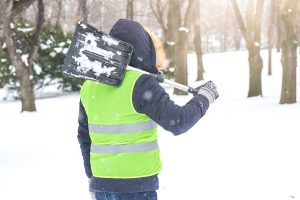North Carolina already had one significant snowfall during December of 2018 and early in 2018, southeast Virginia was struck by a crippling blizzard. Ice, snow, and cold weather can make it extremely difficult to work – especially for construction workers and anyone who works outside. Anyone who walks outside may slip and fall on the ice. Well-known dangers, although rare in our neck of the woods, include hypothermia and frostbite.
Some examples of outdoor work include:
- Construction work
- Snow cleanup crews
- Police officers
- Firefighters
- Sanitation workers
- Emergency medical technicians
- Highway maintenance crews
- Landscapers
- HVAC Technicians
- Utility Workers
- Refuse and Recyclable Collectors
- Surveyors
Cold weather can be relative. Some climates are known for their cold weather and people there understand what steps are needed to protect roads, pipes from bursting due to freezing, and most of all people. Other climates including southern climates often don’t understand how to respond to cold weather and the city crews with their meager supplies and equipment are quickly overwhelmed when extreme winter weather takes over. It is not their fault; it is simply such a rarity that it is not worth the expenditure to purchase the extra equipment.
The OSHA Cold Stress Guide
As with all worker’s compensation claims, there is no requirement to prove fault. If an accident at work causes the employee to be injured, the employee has a right to demand wage loss benefits and payment for the medical costs to get healthy again. The employer is generally liable even if it did everything it could to prevent the accident.
Employers and employees should both understand the risks of working in cold weather and to how to minimize those risks. The Occupational Safety and Health Administration does have some guidelines on what employers can do to help any worker who works outside in extreme cold or a combination of cold and wet weather.
Still, employers are required to comply with “hazard-specific safety and health standards.” Employers must also “provide their employees with a workplace free from recognized hazards likely to cause death or serious physical harm.” Employers should also use standards that are commonplace in their industry.
Risk factors for cold stress
Cold weather includes more than just looking at the temperature. It also requires looking at how wind chill makes it feel colder.
In addition to wind, the following factors can make cold weather more difficult to manage, according to OSHA:
- Wet and damp weather
- Employee fatigue
- Not being properly dressed for winter. Workers should wear layered clothing and have protection for their hands, fingers, feet, toes and face.
- Workers who are in poor health or who have certain risk factors such as diabetes, hypertension, and hypothyroidism should stay inside.
Cold weather places stress on the body by shifting blood flow, over time, away from the extremities to the body’s internal organs, the chest, and the abdomen. This shift plus any exposure of the extremities increases the body’s risk for hypothermia, frostbite, and trench foot.
What is hypothermia?
Hypothermia is a dangerous condition which happens “when body heat is lost faster than it can be replaced.” Another factor is that the body’s temperature drops to below 95 degrees F instead of its normal temperature of 98.6 degrees F. Hypothermia normally occurs at very cold temperatures. It can, however, happen even at temperatures above 40 degrees F if other elements exist. These elements include exposure to rain, sweating, or being submersed in cold water such as falling into a lake or pond.
Hypothermia symptoms. Mild symptoms include shivering and stomping one’s feet to try to get the blood circulating. More serious conditions include a falling body temperature. The worker will stop shivering and may become confused and disoriented. He/she may show signs of losing coordination. Workers may not be able to stand. Their pupils become dilated. Their pulse and breathing slow. Workers with hypothermia may lose consciousness. In tragic cases, they may if they don’t get immediate help.
Treatment for hypothermia. Any worker, supervisor, or helper should call 911 or seek immediate medical help. Some of the many common steps OSHA recommends include:
- Moving the worker to a dry, warm location
- Taking off any wet clothes and putting on dry clothes.
- Covering the whole body including the head and neck with blankets – and with “a vapor barrier.” The face should not be covered.
- If medical help is over 30 minutes away, the worker should
- Be given warm sweet drinks (but no alcoholic drinks) which can help raise the worker’s body temperature. If the person isn’t conscious, then he/she should not be given a drink.
- Placing “warm bottles or hot packs in the armpits, the sides of the chest, and the groin. Call 911 for additional rewarming instructions.”
If the worker isn’t breathing or doesn’t have a pulse, a call to 911 for emergency help should be made immediately. Additionally, OSHA recommends:
- That the general instructions above, other than being given fluids, should be followed
- The worker should be checked again for signs of breathing and for a pulse. The check should be for 60 seconds.
- A 911 operator or emergency medical service worker should start chest compressions – or direct someone at the site on how to perform chest compressions. OSHA’s cold weather guidelines provide that “Chest compressions are recommended only if the patient will not receive medical care within 3 hours.”
The dangers of frostbite?
Frostbite occurs when the skin freezes and the tissue beneath the skin is affected. The lower the temperature, the greater the risk of frostbite. The hands and face are normally the parts of the body affected. In severe cases, amputation may be required.
Frostbite symptoms include red skin with gray and white patches. There’s numbness in the body part affected. There can be a feeling of hardness in the hand, foot, or body part. In severe cases, there may be blisters.
Treatment for frostbite. Generally, the treatments for hypothermia should also be used to treat frostbite. Additional treatment considerations include:
- Do loosely cover the affected body part and try to protect that part.
- Do give the worker warm sweetened drinks – if they are alert but not if they are unconscious. Don’t give the worker any alcohol.
- Don’t do the following:
- Don’t rub the frostbitten party of the body. This can cause more harm.
- Don’t apply water or snow.
- Don’t break the blisters
- Don’t try to rewarm the frostbitten area yourself such as by placing the hand or foot in warm water. This can cause tissue damage. Instead, be sure to get medical help. Medical professionals should understand the right way to warm the affected part.
Attorney Joe Miller Esq. fights for injured workers in North Carolina and Virginia. He’s been helping workers get just recoveries for 30 years. Attorney Miller works with your doctors and independent doctors to fully understand your medical needs. To make an appointment, call 1-(888) 694-1671 or fill out my contact form.



